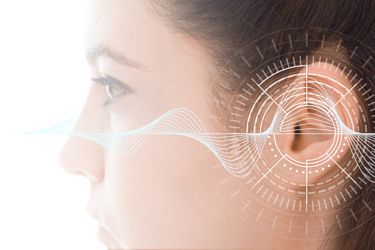Meet Hearables, The Next Revolutionary Medical Devices
A conversation with Jacob Skinner, Ph.D., CEO, Thrive Wearables

Hearables, in-ear devices that use sensors to monitor health, are on the brink of becoming the next revolutionary technology. While in-ear devices have been around for decades in various iterations (used primarily for transmitting sound), the application of this technology in the medical field is a relatively new area to explore. Jacob Skinner, CEO of U.K.-based wearable technology design and development consultants Thrive Wearables, discusses its possibilities.
Why Are Hearables Becoming More Important As A Technology Now?
Skinner: In recent times, sensor technology has shrunk significantly so that all kinds of capabilities can be added to in-ear devices, creating a subcategory of wearable technology that we call hearables. Additionally, most of us carry a supercomputer around in our pockets, which can process data sent to, and received from, in-ear sensors.
 Technology for transferring information is getting better, too. Early Bluetooth headphones traded audio quality for convenience, but today’s wireless earphones are good enough for all but the most dedicated audiophile. Last year, a new standard, Bluetooth LE Audio, was announced that can support hearing aids, streaming to multiple devices, and the Low Complexity Communications Codec (LC3, which transmits at lower bit rates, meaning that the device can use less power and can be less bulky).
Technology for transferring information is getting better, too. Early Bluetooth headphones traded audio quality for convenience, but today’s wireless earphones are good enough for all but the most dedicated audiophile. Last year, a new standard, Bluetooth LE Audio, was announced that can support hearing aids, streaming to multiple devices, and the Low Complexity Communications Codec (LC3, which transmits at lower bit rates, meaning that the device can use less power and can be less bulky).
In addition, almost all of us use earphones of some kind, whether they are wireless, Bluetooth-connected, in-ear buds, or wired headphones that go over the ear. We’re all pretty comfortable with the technology, which helps with patient adherence of this burgeoning field. So, the reason hearables are growing now is a combination of a form factor that we’re all used to and improvements in technology that enable us to make earphones do more than ever. It’s common for wireless earbuds to have a microphone, for example, and a sensor that stops playback when an earphone is removed from the ear. But we are now seeing them become health and fitness devices.
What Can Hearables Bring To The Health And Wellness Space?
Skinner: Some of this technology will simply offer an improved listening experience, based on individual circumstances, and some products are merging traditional ear device uses (listening to music or phone calls) with medical uses. EVEN’s headphones and Nuheara’s IQbuds, for example, both adapt their output to boost frequencies the listener doesn’t hear so well. Everyone’s hearing is slightly different, so compensating for personal limitations or age-related hearing loss can help.
Other technologies use earphones to monitor activity, stress, and even the brain. Sensors can be used for photoplethysmography (PPG), which is the use of light to detect changes in blood volume. That can tell you things like oxygen saturation (SpO2), blood pressure, and pulse rate. Blood pressure is a good measure of overall health, while SpO2 can monitor lung conditions, sleep apnea, and patients with cardiac conditions, among other things. Analyzing changes in this data could provide early indication of heart or blood pressure problems, as well as things like stress or drowsiness.
We can measure heart rate variability, too, which is the time difference between heart beats. A heartbeat of 60 beats per minute is not literally one beat every second. The gaps between beats will vary and the greater the variability, the better condition you are in. Using an in-ear sensor to measure this can help track overall fitness or recovery from a heart procedure.
Another way to monitor heart activity is with electrocardiography (ECG) sensors, which track electrical impulses, while electrodermal activity (EDA) sensors can be used to analyze breathing patterns. Electroencephalography (EEG) sensors, like those in the Kokoon sleep headphones, use electrical signals to monitor brain activity; Kokoon uses the information from its sensors to play white noise for those with trouble sleeping (Kokoon recently won a Red Dot Award in the Product Design category from Red Dot GmbH & Co. KG). Brain monitoring is developing rapidly and could be used to monitor stress, epilepsy, or even complex mental illnesses.
These are far from the only options. Temperature, motion, and other metrics can all be gathered from hearables. Electrical signals can track eye movement, which offers a way to monitor attention and alertness. Measuring changes in the shape of a user’s ear canal can identify facial expressions, which could become a means for controlling these devices or play a role in mood tracking.
What Can We Learn From That Data?
Skinner: Hearables can be useful for telling us what is happening in the body right now. They could tell you whether you are within the correct heart rate range for your exercise plan, for instance, and use an audible signal to tell you to speed up or slow down.
But trend data can be even more useful. Once a system begins to understand what is normal for your body, it can use anomalies to detect potential health problems. Combining several measures, along with things like voice recognition and head movement, could be a powerful indicator of overall health and well-being. Abnormal data could trigger anything from recommended deep breathing exercises for stress relief to scheduling an appointment with a clinician based on emerging cardiac symptoms.
When many people use these devices, their data can be analyzed in aggregate – with appropriate privacy controls. That would allow artificial intelligence and analytics to look for patterns and draw conclusions beyond those that can be derived from individual data. We might identify new warning signs of heart disease, for example, based on data collected from millions of people before they showed any symptoms.
Many of these applications are some time away from being reliable and widely used, but the pace of innovation is fast and increasing. We are just a few years away from widespread consumer use of hearables for health monitoring, but specific, niche medical uses are already happening.
Why Are Hearables Ideal For Data Collection Rather Than Wrist-Based Wearables, And What Are The Technological Challenges?
Skinner: Wearable tech for health and wellness has so far focused on wrist-based devices. However, signals from the ear are as much as 100-times clearer than those from the wrist. The inside of the ear is dark, closer to the body’s core, and the arteries are nearer the surface of the skin, which makes heart rate monitoring easier.
On the wrist, in contrast, sensors must work around muscles and tendons. During exercise, people tend to move their wrists a lot, while their heads stay relatively stable. Wrist-based monitors shine a light into the skin to detect blood flow, but if the device isn’t fitted snugly to the wrist, light can get in and reduce the effectiveness of the sensor. And unlike the inner ear, the wrist gets sweaty, which can make it hard for sensors to capture a good signal, resulting in variable quality insights.
The ear is also a good location for monitoring signals from the brain and eyes, and is less obtrusive than brain-computer interfaces that must be worn on the head. Speech recognition is easily handled by a microphone on an earpiece, and head movement is easily tracked, too.
The challenge with a device that you wear in your ear is that it has to be small and light, which obviously restricts how many sensors you can pack in. The sensors have to be small and there has to be room for a battery to power them. For a consumer device, you need to fit in speakers and a microphone, too. It’s a design challenge to make something that is comfortable to wear, with a practical battery life and the features that provide value. However, since the pioneering work of the German startup Bragi, a lot of investment has gone into creating new technologies that are specifically designed to work at ultra-low power and in extremely constrained form factors. There is also historical work in the hearing aid space, and this level of advancement has meant that hearable technology is able to move at significant pace. With this backdrop, and due to the consumer pull and market validation of AirPods, new sensors and advanced technologies are finding their way into our ear-worn wearables. These factors somewhat mitigate the challenges we face in product development.
What Does The Future Look Like?
Skinner: The industry will see a boom in hearables. The COVID-19 pandemic slowed things down somewhat. Hearable shipments grew by 258 percent in 2019 but only 37 percent last year, mostly because of supply chain disruption during lockdown. However, we will see growth increase again because of the amount of innovation in the sector. The market is still expected to be worth $146 billion by the end of the decade.
Consumer devices are going to continue to add more features, with many of them becoming alternatives to hearing aids for the hundreds of millions of people with disabling hearing loss. Health and fitness remains a natural area for growth, too, because so many people like to wear earphones while exercising and they are naturally interested in their overall wellness. We are also likely to see these devices integrate with augmented reality (AR) and virtual reality (VR) use cases — particularly in creating “surround sound” effects and greater personal assistant capabilities.
More specialized use cases have fascinating possibilities. We can monitor recovery from heart procedures more effectively than ever before, for example, and we are just beginning to look into the possibilities for mental health.
This year is an especially pivotal year for ear-based technology. Through my work at Thrive, I am seeing innovators in this space, and the products coming along are very exciting. It’s clear that hearables represent a fantastic opportunity to measure high-fidelity signals and turn these into a new generation of ultra-sensitive and accurate health technologies.
